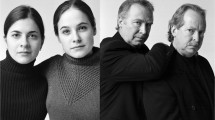Abstract
Adoption studies provide an opportunity to check on twin-study inferences about genetic and environmental effects on personality. The Texas Adoption Project obtained personality tests and ratings from members of 300 adoptive families: MMPIs and 16PFs for adults, and Cattell scales and parents' ratings for children. Overall there was little personality resemblance among family members, either biologically or adoptively related. Median correlations were typically positive, but under 0.10. Elimination of a rating bias and the use of multiple correlations did not yield notably higher levels of prediction, but restriction to a subsample of well-measured children provided higher correlations and more evidence of heritability, particularly in the extraversion domain.
Similar content being viewed by others
References
Anastasi, A. (1958).Differential Psychology, 3rd ed., Macmillan, New York.
Cattell, R. B. (1973).Personality and Mood by Questionnaire, Jossey-Bass, San Francisco.
Cattell, R. B., and Cattell, M. D. L. (1969).Handbook for the Jr.-Sr. High School Personality Questionnaire “HSPQ”, Institute for Personality and Ability Testing, Champaign, Ill.
Cattell, R. B., Eber, H. W., and Tatsuoka, M. (1970).Handbook for the Sixteen Personality Factor Questionnaire, 3rd ed., Institute for Personality and Ability Testing, Champaign, Ill.
Coppen, A., Cowie, V., and Slater, E. (1965). Familial aspects of “neuroticism” and “extraversion.”Br. J. Psychiat. 111:70–83.
Crook, M. N. (1937). Intra-family relationship in personality test performance.Psychol. Rec. 1:479–502.
Dielman, T. (1977). Rating factors at the child level. In Cattell, R. B., and Dreger, R. (eds.),Handbook of Modern Personality Theory, Halsted Press, New York, pp. 64–68.
Dixon, L. K., and Johnson, R. C. (1980).The Roots of Individuality, Brooks/Cole, Monterey, Calif.
Eaves, L. J., Last, K. A., Young, P. A., and Martin, N. G. (1978). Model-fitting approaches to the analysis of human behavior.Heredity 41:249–320.
Hill, M. S., and Hill, R. N. (1973). Hereditary influence on the normal personality using the MMPI.Behav. Genet. 3:133–144.
Horn, J. M., Loehlin, J. C., and Willerman, L. (1979). Intellectual resemblance among adoptive and biological relatives: The Texas Adoption Project.Behav. Genet. 9:177–207.
Insel, P. M. (1974). Maternal effects in personality.Behav. Genet. 4:133–143.
Klein, T. W., and Cattell, R. B. (1976). Heritability and personality: A twin analysis with full sib controls.Behav. Genet. 6:111 (abstract).
Loehlin, J. C. (1977). Psychological genetics, from the study of human behavior. In Cattell, R. B., and Dreger, R. M., (eds.),Handbook of Modern Personality Theory, Halsted Press, New York, pp. 329–347.
Loehlin, J. C., and Nichols, R. C. (1976).Heredity, Environment, and Personality, University of Texas Press, Austin.
Lytton, H. (1977). Do parents create, or respond to, differences in twins?Dev. Psychol. 13:456–459.
Matheny, A. P., Jr., Wilson, R. S., and Dolan, A. B. (1976). Relations between twins' similarity of appearance and behavioral similarity.Behav. Genet. 6:343–351.
Plmin, R., Willerman, L., and Loehlin, J. C. (1976). Resemblance in appearance and the equal environments assumption in twin studies of personality traits.Behav. Genet. 6:43–52.
Porter, R. B., and Cattell, R. B. (1972).Handbook for the Children's Personality Questionnaire (the CPQ), Institute for Personality and Ability Testing, Champaign, Ill.
Scarr, S. (1968). Environmental bias in twin studies.Eugen. Quart. 15:34–40.
Scarr, S., and Carter-Saltzman, L. (1979). Twin method: Defense of a critical assumption.Behav. Genet. 9:527–542.
Scarr, S., Webber, P. L., Weinberg, R. A., and Wittig, M. A. (1981).J. Personal. Soc. Psychol. 40:885–898.
Schaie, K. W. (1962) On the equivalence of questionnaire and rating data.Psychol. Rep. 10:521–522.
Author information
Authors and Affiliations
Additional information
This research was supported by Grant MH 24280 from the National Institute of Mental Health. We are grateful to the director and staff of the adoption agency, to the psychologists who assisted in the testing, and especially to the adoptive families for their cooperation in the study. We appreciate the helpful comments of the anonymous reviewers of an earlier version of this paper.
Rights and permissions
About this article
Cite this article
Loehlin, J.C., Horn, J.M. & Willerman, L. Personality resemblance in adoptive families. Behav Genet 11, 309–330 (1981). https://doi.org/10.1007/BF01070814
Received:
Accepted:
Issue Date:
DOI: https://doi.org/10.1007/BF01070814




